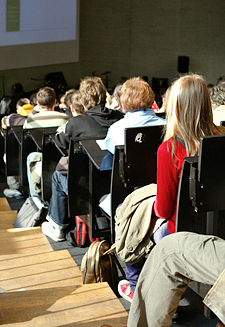Highlights
Click here to get to:
Highlights Research Focus I

Cai, Binder, Macromol Rapid Commun. 2023, 202300440
Triggered Crosslinking of Main-Chain Enediyne Polyurethanes via Bergman-Cyclization. Cai, Y.; Binder, W. H.*, Macromol. Rapid Commun., 2023, 202300440, https://doi.org/10.1002/marc.202300440
Crosslinking chemistries occupy an important position in polymer modification with a particular importance when triggered in response to external stimuli. Enediyne (EDY) moieties are used as functional entities in this work, known to undergo a pericyclic Bergman cyclization (BC) to induce a triggered crosslinking of polyurethanes (PU) via the intermediately formed diradicals. Diamino-EDYs, where the distance between the enyne-moieties is known to be critical to induce a BC, are placed repetitively as main-chain structural elements in isophorone-based PUs to induce reinforcement upon heating, compression, or stretching. A 7-day compression under room temperature results in a ≈69% activation of the BC, together with the observation of an increase in tensile strength by 62% after 25 stretching cycles. Purely heat-induced crosslinking contributes to 191% of the maximum tensile strength in comparison to the virgin PU. The BC herein forms an excellent crosslinking strategy, triggered by heat or force in PU materials. © 2023 The Authors. Macromolecular Rapid Communications published by Wiley‐VCH GmbH

Macromol. Rapid Commun., 2023, 2300464
Stability of Quadruple Hydrogen Bonds in an Ionic Liquid Environment. Li, C.; Bhandary, R.; Marinow,A.; Bachmann, S.; Pöppler, A.-C.; Binder, W. H.* Macromol. Raid Commun., 2023, 2300464, https://doi.org/10.1002/marc.202300464
Hydrogen bonds (H-bonds) are highly sensitive to the surrounding environments owing to their dipolar nature, with polar solvents kown to significantly weaken H-bonds. Herein, the stability of the H-bonding motif ureidopyrimidinone (UPy) is investigated, embedded into a highly polar polymeric ionic liquid (PIL) consisting of pendant pyrrolidinium bis(trifluoromethylsulfonyl)imide (IL) moieties, to study the influence of such ionic environments on the UPy H-bonds. The content of the surrounding IL is changed by addition of an additional low molecular weight IL to further boost the IL content around the UPy moieties in molar ratios of UPy/IL ranging from 1/4 up to 1/113, thereby promoting the polar microenvironment around the UPy-H-bonds. Variable-temperature solid-state MAS NMR spectroscopy and FT-IR spectroscopy demonstrate that the UPy H-bonds are largely present as (UPy-) dimers, but sensitive to elevated temperatures (>70 °C). Subsequent rheology and DSC studies reveal that the ILs only solvate the polymeric chains but do not interfere with the UPy-dimer H-bonds, thus accounting for their high stability and applicability in many material systems. © 2023 The Authors. Macromolecular Rapid Communications published by Wiley‐VCH GmbH
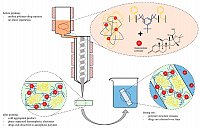
Hilgeroth, Polymers, 2022, 3742
3D-printing of Triamcinolone Acetonide in Triblock Copolymers of Styrene-Isobutylene-Styrene as a Slow Release System. Hilgeroth, P., et al. Polymers 2022 DOI: https://doi.org/10.3390/polym14183742
Additive manufacturing has a wide range of applications and has opened up new methods of drug formulation, in turn achieving attention in medicine. We prepared styrene–isobutylene–styrene triblock copolymers (SIBS; Mn = 10 kDa–25 kDa, PDI 1,3–1,6) as a drug carrier for triamcinolone acetonide (TA), further processed by fused deposition modeling to create a solid drug release system displaying improved bioavailability and applicability. Living carbocationic polymerization was used to exert control over block length and polymeric architecture. Thermorheological properties of the SIBS polymer (22.3 kDa, 38 wt % S) were adjusted to the printability of SIBS/TA mixtures (1–5% of TA), generating an effective release system effective for more than 60 days. Continuous drug release and morphological investigations were conducted to probe the influence of the 3D printing process on the drug release, enabling 3D printing as a formulation method for a slow-release system of Triamcinolone.
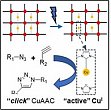
A Mechanochemically Active Metal-Organic Framework (MOF) Based on Cu-Bis-NHC-Linkers: Synthesis and Mechano-Catalytic Activation. Shinde, K., et al. Polymers 2022 DOI: https://doi.org/10.1002/macp.202200207
Porous coordination polymers, more commonly known as metal-organic frameworks (MOFs), are constructed from metal ions and organic linkers which form a robust network-like structure similar to very dense polymeric networks. In this work the mechanochemical activation of a MOF is reported, based on the previous results on the mechanochemical activation of latent Cu(I)-based N-heterocyclic carbenes (NHCs) embedded covalently in various polymers. A mechanochemically triggered copper-catalyzed azide-alkyne cycloaddition (CuAAC) is achieved using an NHC-MOF, constructed from 1,3-bis(4-carboxyphenyl)imidazolium chloride as organic linker. A Cu(I) bis(NHC) is embedded into the MOF analogous to ([Zn4O{Cu(L)2}2]) using the organic bis-NHC ligand, in turn generating a largely amorphous MOF. On activation by ultrasound, the MOF containing 4.66% of Cu shows mechanochemical activation to obtain Cu(I), subsequently triggering a CuAAC with conversions up to 26.5% as monitored by the reaction of benzylazide and phenylacetylene to yield 1-benzyl-4-phenyl-1H-1,2,3-triazole over a period of 20 sonication cycles. With this knowledge in solution, there are prospects to transfer this mechanochemical activity into polymer networks with embedded MOFs to detect stress in hybrid materials.

Thümmler, J.F., Macromol. Rapid. Commun., 2022, 202200618
Tuning the internal compartmentation of single-chain nanoparticles as fluorescent contrast agents. Thümmler, J. F., et al. Macromol. Rapid. Commun. 2022 DOI: https://doi.org/10.1002/marc.202200618
Controlling the internal structures of single-chain nanoparticles (SCNPs) is an important factor for their targeted chemical design and synthesis, especially in view of nanosized compartments presenting different local environments as a main feature to control functionality. We here design SCNPs bearing near-infrared fluorescent dyes embedded in hydrophobic compartments for use as contrast agents in pump–probe photoacoustic (PA) imaging, displaying improved properties by the location of the dye in the hydrophobic particle core. Compartment formation is controlled via single-chain collapse and subsequent crosslinking of an amphiphilic polymer using external crosslinkers in reaction media of adjustable polarity. Different SCNPs with hydrodynamic diameters of 6-12 nm bearing adjustable label densities are synthesized. It is found that the specific conditions for single-chain collapse have a major impact on the formation of the desired core–shell structure, in turn adjusting the internal nanocompartments together with the formation of excitonic dye couples, which in turn increase their fluorescence lifetime and PA signal generation. SCNPs with the dye molecules accumulate at the core also show a nonlinear PA response as a function of pulse energy—a property that can be exploited as a contrast mechanism in molecular PA tomography.

Du, F. et al, Int. J. Pharamaceutics, 2022, 122023
3D-printing of the polymer/insect-repellent system poly (l-lactic acid)/ethyl butylacetylamino- propionate (PLLA/IR3535). Du, F., et al. Int. J. Pharmaceutics 2022 DOI: https://doi.org/10.1016/j.ijpharm.2022.122023
The polymer/solvent system poly (l-lactic acid)/ethyl butylacetylaminopropionate (PLLA/IR3535) is regarded as an insect-repellent-delivery system, serving, e.g., for fighting mosquito-borne tropical diseases. In such systems the solid polymer hosts the liquid repellent, with the latter slowly released to the environment, expelling mosquitoes. As a new approach, exceeding prior work about application of different technologies to obtain such devices, in this work, samples of the polymer/repellent system PLLA/IR3535 were prepared by 3D-printing. The experiments showed that it is possible to print 3D-parts containing up to 25 m% repellent, with an only minor loss of repellent during the printing process. For samples containing low amount of repellent, crystallization of PLLA was suppressed due to the rather fast cooling step and the low bed temperature of around 25 °C, being lower than the glass transition temperature of the homogeneous polymer/repellent strands. At higher repellent concentration, due to the lowering of the glass transition temperature to near or even below ambient temperature, the crystallinity slowly increased during storage after printing. For all samples, regardless of the initial repellent concentration, the repellent-release rate increases with temperature, and at ambient temperature the release-time constant is in the order of 10 days. The study successfully proved the applicability of the technology of extrusion-based 3D-printing for the preparation of polymer parts with a specific shape/design containing mosquito-repellent at a concentration which raises the expectation to be used as a repellent delivery-device.
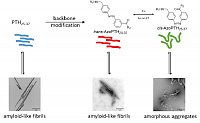
Paschold, A. et al, Biomedicines, 2022, 1512
Modulating the fibrillization of parathyroid-hormone (PTH) peptides: azo-switches as reversible and catalytic entities. Paschold, A., et al. Biomedicines 2022 DOI: https://doi.org/10.3390/biomedicines10071512
We here report a novel strategy to control the bioavailability of the fibrillizing parathyroid hormone (PTH)-derived peptides, where the concentration of the bioactive form is controlled by an reversible, photoswitchable peptide. PTH1–84, a human hormone secreted by the parathyroid glands, is important for the maintenance of extracellular fluid calcium and phosphorus homeostasis. Controlling fibrillization of PTH1–84 represents an important approach for in vivo applications, in view of the pharmaceutical applications for this protein. We embed the azobenzene derivate 3-{[(4-aminomethyl)phenyl]diazenyl}benzoic acid (3,4′-AMPB) into the PTH-derived peptide PTH25–37 to generate the artificial peptide AzoPTH25–37 via solid-phase synthesis. AzoPTH25–37 shows excellent photostability (more than 20 h in the dark) and can be reversibly photoswitched between its cis/trans forms. As investigated by ThT-monitored fibrillization assays, the trans-form of AzoPTH25–37 fibrillizes similar to PTH25–37, while the cis-form of AzoPTH25–37 generates only amorphous aggregates. Additionally, cis-AzoPTH25–37 catalytically inhibits the fibrillization of PTH25–37 in ratios of up to one-fifth. The approach reported here is designed to control the concentration of PTH-peptides, where the bioactive form can be catalytically controlled by an added photoswitchable peptide.
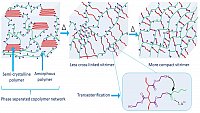
Krishnan, B.P. et al, Polymers, 2022, 2456
Design, synthesis and characterization of vitrimers with low topology freezing transition temperature. Krishnan, B. P., et al. Polymers 2022 DOI: https://doi.org/10.3390/polym14122456
Vitrimers are crosslinked polymeric materials that behave like fluids when heated, regulated by the kinetics of internal covalent bond-exchange that occurs rapidly at or above the topology freezing transition temperature (Tv) of the vitrimer, making these materials readily reprocessable and recyclable. We report two novel multiphase vitrimeric materials prepared by the cross-linking of two polymers, namely poly(triethylene glycol sebacate) and poly(2-hydroxyethyl acrylate), using zinc acetate or tin(II) 2-ethylhexanoate as catalysts, which exhibit significantly low Tv temperatures of 39 °C and 29 °C, respectively. The transesterification reactions allow rapid and pronounced stress relaxation at high temperatures, following the Arrhenius law. The lower Tv of these vitrimers could be attributable to the flexible long chains of these polymers and the significant excess of OH moieties present along the main chain of the polymer. The design of such multiphase vitrimers is not only useful for the practical application of vitrimers to reduce plastic waste but could also facilitate further development of functional polymer materials that can be reprocessed at low temperatures.
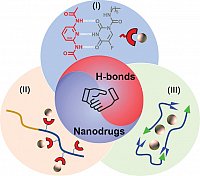
Chen S. et al, J. Macromol. Rapid Commun. 2022, 202200168
Hydrogen-Bonds Mediated Nanomedicine: Design, Synthesis and Applications. Chen, S. P., et al. J. Macromol. Rapid Commun. 2022 DOI: https://doi.org/10.1002/marc.202200168
Hydrogen-bonds (H-bonds) bridge artificial and biological sciences, implementing dynamic properties into materials and (macro)molecules, which cannot be achieved via purely covalent bonds. In this review, the current state-of-the-art for designing novel H-bonded nanomedicines for precise diagnosis, and targeted therapeutic drugs delivery are highlighted.
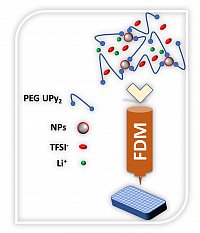
Katcharava, Z. et al, Nanomaterials, 2022, 1859
3D printable composite polymer electrolytes: influence of SiO2 nanoparticles on 3D-printability. Katacharava, Z., et al. Nanomaterials 2022 DOI: https://doi.org/10.3390/nano12111859
We here demonstrate the preparation of composite polymer electrolytes (CPEs) for Li-ion batteries, applicable for 3D printing process via fused deposition modeling. The prepared composites consist of modified poly(ethylene glycol) (PEG), lithium bis(trifluoromethylsulfonyl)imide (LiTFSI) and SiO2-based nanofillers. PEG was successfully end group modified yielding telechelic PEG containing either ureidopyrimidone (UPy) or barbiturate moieties, capable to form supramolecular networks via hydrogen bonds, thus introducing self-healing to the electrolyte system. Silica nanoparticles (NPs) were used as a filler for further adjustment of mechanical properties of the electrolyte to enable 3D-printability. The surface functionalization of the NPs with either ionic liquid (IL) or hydrophobic alkyl chains is expected to lead to an improved dispersion of the NPs within the polymer matrix. Composites with different content of NPs (5%, 10%, 15%) and LiTFSI salt (EO/Li+ = 5, 10, 20) were analyzed via rheology for a better understanding of 3D printability, and via Broadband Dielectric Spectroscopy (BDS) for checking their ionic conductivity. The composite electrolyte PEG 1500 UPy2/LiTFSI (EO:Li 5:1) mixed with 15% NP-IL was successfully 3D printed, revealing its suitability for application as printable composite electrolytes.
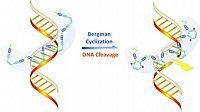
Cai, Y. et al, Polmyer Chemistry, 2022, 3412
Bergman cyclization of main-chain enediyne polymers for enhanced DNA cleavage. Cai, Y., et al. Polym. Chem. 2022 DOI: https://doi.org/10.1039/D2PY00259K
Since the discovery of the role of enediynes in natural antibiotics (such as calicheamicines) via in situ diradical-induced DNA strand cleavage, Bergman cyclization has attracted fervent attention for decades. Thus, Bergman cyclization is widely used in pharmaceutics, synthesis, and polymer chemistry as a trigger for the generation of diradicals. Whereas applications of the Bergman cyclization in polymers mostly rely on side-chain linked enediynes, strategies to embed enediynes as the main repeating units into polymers are not reported yet. Here, the synthesis of main-chain enediyne polymers was accomplished, allowing to embed and control the reactivity of the diamino enediynes via polycondensation into polyimines. Such main-chain enediyne polymers in solution exert a chain-length dependent DNA cleavage activity under physiological conditions, additionally tunable by modulating the stereoelectronic environment via their substitution patterns. Photochemical activation generates long-lived free radicals as verified via electron paramagnetic resonance (EPR) spectroscopy, with rates of their formation comparable to those in DNA cleavage experiments.

Chen, S. et al, Angew.Chem.Int.Ed., 2022, e202203876
Hydrogen-Bonded Supramolecular Polymer Adhesives: Straightforward Synthesis and Strong Substrate Interaction. Chen, S., et al. Angew. Chem. Int. Ed. 2022 DOI: https://doi.org/10.1002/anie.202203876
A High-performance adhesives are of great interest in view of industrial demand. We herein identify a straightforward synthetic strategy towards universal hydrogen-bonded (H-bonded) polymeric adhesives, using a side-chain barbiturate (Ba) and Hamilton wedge (HW) functionalized copolymer. Starting from a rubbery copolymer containing thiolactone derivatives, Ba and HW moieties are tethered as pendant groups via an efficient one-pot two-step amine-thiol-bromo conjugation. Hetero-complementary Ba/HW interactions thus yield H-bonded supramolecular polymeric networks. In addition to an enhanced polymeric network integrity induced by specific Ba/HW association, the presence of individual Ba or HW moieties enables strong binding to a range of substrates, outstanding compared to commercial glues and reported adhesives.

Rupp H. et al, Adv. Mater.Technol., 2022, 2200088
Printable Electrolytes: tuning 3D printing by multiple hydrogen bonds and added inorganic lithium-salts (LiTFSI). Rupp, H., et al. Adv. Mater. Technol. 2022 DOI: https://doi.org/10.1002/admt.202200088
Here, the 3D-printing of supramolecular polymer electrolytes is reported, able to be manufactured via 3D-printing processes, additionally dynamically compensating for volume changes. A careful mechanical design, in addition to rheological effects observed for different additives to the electrolyte, is investigated and adjusted, in order to achieve printability via an extrusion process to generate a conductive electrode material. Qudruple-hydrogen bonds (UPy) act as supramolecular entities for the desired dynamic properties to adjust printability, in addition to added LiTFSi-salts to achieve ionic conductivities of ≈10–4 S cm–1 at T = 80 °C. Three different telechelic UPy-PEO/PPO-UPy-polymers with molecular weights ranging from Mn = 600–1500 g mol−1 were investigated in view of their 3D-printability by FDM-processes. It is found that there are three effects counterbalancing the rheological properties of the polymers: besides temperatures, which can be used as a known tool to adjust melt-rheology, also the addition of lithium-salts in junction with the polymers crystallinity exerts a major toolbox to 3D-print these electrolytes. Using specific compositions with Li/EO-ratios from 20:1, 10:1, and 5:1, the rheological profile can be adjusted to reach the required printability window. AT-IR-investigations clearly indicate a weakening of the UPy-bonds by the added Li+ ions, in addition to a reduction of the crystallinity of the PEO-units, further changing the rheological profile. The so generated electrolytes are printable systems for novel electrolytes.

Wu, Y. et al, Polym. Chem., 2022, 1010
Hydrogen-bonded supramolecular polymer-micelles with pH/photothermal-responsive carmofur release and combined chemo-photothermal therapy. Wu, Y., et al. Polym. Chem. 2022 DOI: https://pubs.rsc.org/en/content/articlelanding/2022/py/d1py01634b
Integrating biomedical applications (e.g., drug delivery) into supramolecular chemistry is a promising strategy. This work targets the construction of hydrogen-bonded (H-bonded) supramolecular polymeric micelles loaded with chemotherapy drugs (carmofur) and photothermal agents (IR780) for combined chemo-photothermal therapies (CT/PTT).
Vitrimers based on Bio-derived Chemicals: Overview and Future Prospects. Balaji, K., et al. Chem. Eng. J. 2021 DOI: https://doi.org/10.1016/j.cej.2021.133261
The perspective of using recyclable and biobased materials in the vitrimeric concept is attractive, in view of the regulatory guidelines and pressing need to reduce CO2-emissions. The expansion of viable bio-based polymeric materials is gaining increased attention to achieve sustainable development goals . Although durability, cost, and performance still limit their real life applications, these limitations can be overcome through state-of-the-art bio-vitrimeric materials displaying thermoset like mechanical and thermal properties as well as thermoplastic like malleable and thus recyclable properties. Bio-derived chemicals based vitrimers can be of advantage, where material design is made from scratch, allowing to plan material properties in line with their future life cycle from the very beginning. This article emphasizes the current needs of vitrimers based on bio-derived chemicals, including their recycling, reprocessing, and self-healing properties, along with their advantages and potential obstacles from todays’ perspective. The article also identifies potential bio-derivatives as attractive building blocks for vitrimers because of their potential for sustainability.
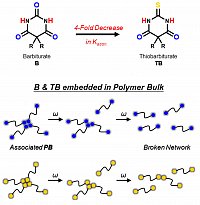
Li, C. et al, Int.J.Macromol.Sci., 2021, 12679
Comparing C2=O and C2=S Barbiturates: Different Hydrogen Bonding Patterns of Thiobarbiturates in Solution and the Solid State. Li, C., et al. Int. J. Macromol. Sci. 2021 DOI: https://www.mdpi.com/1422-0067/22/23/12679
Carbonyl-centered hydrogen bonds with various strength and geometries are often exploited in materials to embed dynamic and adaptive properties, with the use of thiocarbonyl groups as hydrogen-bonding acceptors remaining only scarcely investigated. We herein report a comparative study of C2=O and C2=S barbiturates in view of their differing hydrogen bonds, using the 5,5-disubstituted barbiturate B and the thiobarbiturate TB as model compounds. Owing to the different hydrogen-bonding strength and geometries of C2=O vs. C2=S, we postulate the formation of different hydrogen-bonding patterns in C2=S in comparison to the C2=O in conventional barbiturates. To study differences in their association in solution, we conducted concentration- and temperature-dependent NMR experiments to compare their association constants, Gibbs free energy of association ∆Gassn., and the coalescence behavior of the N-H‧‧‧S=C bonded assemblies. In Langmuir films, the introduction of C2=S suppressed 2D crystallization when comparing B and TB using Brewster angle microscopy, also revealing a significant deviation in morphology. When embedded into a hydrophobic polymer such as polyisobutylene, a largely different rheological behavior was observed for the barbiturate-bearing PB compared to the thiobarbiturate-bearing PTB polymers, indicative of a stronger hydrogen bonding in the thioanalogue PTB. We therefore prove that H-bonds, when affixed to a polymer, here the thiobarbiturate moieties in PTB, can reinforce the nonpolar PIB matrix even better, thus indicating the formation of stronger H-bonds among the thiobarbiturates in polymers in contrast to the effects observed in solution.
3D printing of solvent-free supramolecular polymers. Rupp, H., Binder W. H. Frontiers in Chemistry 2021 DOI: https://doi.org/10.3389/fchem.2021.771974
Additive manufacturing has significantly changed polymer science and technology by engineering complex material shapes and compositions. With the advent of dynamic properties in polymeric materials as a fundamental principle to achieve, e.g., self-healing properties, the use of supramolecular chemistry as a tool for molecular ordering has become important. By adjusting molecular nanoscopic (supramolecular) bonds in polymers, rheological properties, immanent for 3D printing, can be adjusted, resulting in shape persistence and improved printing. We here review recent progress in the 3D printing of supramolecular polymers, with a focus on fused deposition modelling (FDM) to overcome some of its limitations still being present up to date and open perspectives for their application.
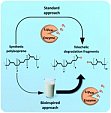
Enzymatic degradation of synthetic polyisoprenes via surfactant-free polymer emulsification. Adjedje, V. B. K., et al. Green Chemistry 2021 DOI: 10.1039/D1GC03515K
We report the enzymatic degradation of a synthetic polyisoprene with a cis : trans ratio of 56 : 27 for the first time. Utilizing a bioinspired surfactant-free emulsification strategy in water resulted in substantially increased enzymatic activities with the latex clearing protein LcpK30.

Wang, H. et al, Polym. Chem., 2021, 6300
Hydrogen-bonding mediated self-assembly of amphiphilic ABA triblock copolymers into well defined giant vesicles. Wang, H., et al. Polym. Chem. 2021 DOI: https://doi.org/10.1039/D1PY01061A
Giant vesicles represent an extremely useful system to mimic biomembranes; however, the available methodologies towards easy and direct vesicle construction are still scarce. By designing a hydrogen-bonding (H-bonding) amphiphilic ABA triblock copolymer and introducing 2,6-diaminopyridine (DAP) moieties as pendant groups into the middle hydrophobic block, we demonstrate a straightforward and effective self-assembly strategy to form giant vesicles (∼3 μm in diameter) via a combination of H-bonding and amphiphilic interactions. The spatial distribution of these DAP moieties is tightly related to local organization, featuring an interchain H-bonding association ascribed to the dimerization of DAP moieties, thus offering a straightforward pathway towards effective generation of giant vesicles, as proven by scanning electron microscopy (SEM) and transmission electron microscopy (TEM) investigations. Moreover, atomic force microscopy (AFM) studies further prove the hollow interior of these vesicular morphologies. This study provides a new opportunity for the design of supramolecular polymers, serving as polymeric vesicle scaffolds in materials design and may act as red-blood-cell-like containers in delivery and microreactor applications.
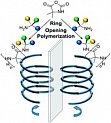
Chiral amines as initiators for ROP and chiral induction on poly(2-aminoisobutyric acid) chains. Rohmer, M., et al. Polym. Chem. 2021 DOI: https://doi.org/10.1039/D1PY01021B
Aminoisobutyric acid (Aib) is a prominent achiral amino acid known for its helical building properties, generating left- and right-handed helices without any preference. We here report an investigation on several short chain poly(Aib)s synthesized by ring opening polymerization (ROP) of Aib-N-carboxy-anhydrides (Aib-NCA) with structurally different chiral amines acting as both, initiator and chiral induction agent. To achieve the desired structures with a degree of polymerization of 10 up to 20 repeating units, different synthetic techniques such as solution and interfacial polymerization have been used leading to improved purity and precise end group control of the resulting polymers as confirmed by MALDI-ToF-MS and 1H-NMR spectroscopy. By adding a chiral center at the C-terminus of the polymer chain we can control the direction of the screw sense, since the polymers are adopting the chirality of the initiator following the sergeant-and-soldier principle. Circular-Dichroism (CD) spectroscopy measurements revealed an exceptionally good chiral induction by the investigated initiators. Furthermore, variation of the solvent from hexafluoroisopropanol (HFIP) to water resulted in a significant change of CD signals, featuring a surprising aggregation of the poly(amino acids) into globular aggregates in water in the range of 50 to 200 nm, which accounts for changes in chiral induction.
Towards in-line detection of thermal polymer degradation. Funtan, A., et al. Research Outreach, 2021 DOI: 10.32907/RO-125-1679181891

Chen, S. et al, Polym. Chem. 2021, 4111
Synthesis and self-aggregated nanostructures of hydrogen-bonding polydimethylsiloxane. Chen, S., et al. Polym. Chem. 2021 DOI: https://doi.org/10.1039/D1PY00513H
Gaining control over assembled nanostructures is an important aspect in nanotechnology and materials. Compared to specific directional interactions, self-aggregation of clusters driven by the forces of hydrogen-bonding (H-bonding) polymers, constitute a novel and simple strategy toward the tuning of nanostructures. In this work, we first demonstrate the precise synthesis of tailored polydimethylsiloxane (PDMS) at their α-ends bearing a series of H-bonding moieties (e.g., barbiturate (Ba), 2,4,6-triaminopyrimidine (TAP) and Hamilton wedge (HW)), using a robust copper(I)-catalyzed azide–alkyne cycloaddition (CuAAC) reaction. Complete end group functionalization is proven by NMR and matrix-assisted laser desorption/ionization time of flight mass spectrometry (MALDI-MS) methods. Self-aggregated H-bonds are indeed formed in the melt state from the obtained H-bonding PDMS, evidenced by temperature dependent solid-state 1H MAS NMR. Subsequent small angle X-ray scattering (SAXS) studies unveil a profound picture of nanostructures, including lamellae (LAM), hexagonally packed cylinders (HPC), body-centered cubic spheres (BCC) and disordered micelles (DIM). We found that these morphologies are influenced by the molecular weight of the PDMS (1200, 5800 and 11 300 g mol−1), as well as by the nature of H-bonding moieties (e.g., Ba, TAP, HW), proving that both the immiscibility parameter and the volume fraction between nonpolar PDMS and polar H-bonding moieties determine the final structures. Moreover, we also demonstrate a thermally reversible order–disorder transition (ODT) in the observed nanostructures, induced by the H-bonding self-aggregation as observed by temperature-dependent SAXS investigations. The strategy to engineer nanostructures to form the cluster and aggregation of H-bonding polymers is significant, providing new insights to control the supramolecular polymer chain organization and phase separation effects.
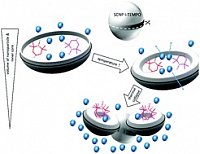
Roos, A. et al, Soft Matter, 2021, 7032
Nanoscale structure and dynamics of thermoresponsive single-chain nanoparticles investigated by EPR spectroscopy. Roos, A. H., et al. Soft Matter 2021 DOI: https://doi.org/10.1039/D1SM00582K
We characterize temperature-dependent macroscopic and nanoscopic phase transitions and nanoscopic pre-transitions of water-soluble single chain nanoparticles (SCNPs). The studied SCNPs are based on polymers displaying lower-critical solution temperature (LCST) behavior and show nanoscale compartmentation. SCNPs are amenable to continuous wave electron paramagnetic resonance (CW EPR) spectroscopy to study how amphiphilic, non-covalently added nitroxide spin probes or covalently attached spin labels sample their environment concerning nanoscale structures (polarity, hydrophilicity/-phobicity) and dynamics. These SCNPs are formed through single-chain collapse and have been shown to have nanosized compartments that are rigidified during the crosslinking process. We analyze the temperature-dependent phase transitions of spin-labeled SCNPs by rigorous spectral simulations of a series of multicomponent EPR-spectra that derive from the nanoinhomogeneities (1) that are due to the single-chain compartmentation in SCNPs and (2) the transformation upon temperature change due to the LCST behavior. These transitions of the SCNPs and their respective polymer precursors can be monitored and understood on the nanoscale by following EPR-spectroscopic parameters like hyperfine couplings that depend on the surrounding solvent molecules or Heisenberg spin exchange between small molecule spin probes or covalently attached spin labels in the nanocompartments. In particular, for one SCNP, we find an interesting behavior that we ascribe to the properties of the nanosized inner core with continuous effects before and jump-like changes after the macroscopic thermal collapse, indicating highly efficient desolvation and compaction upon an increase in temperature and aggregation of individual nanoparticles above the collapse temperature.
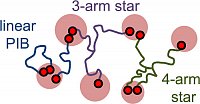
Mordvinkin, A. et al, Macromolecules, 2021, 5056
Rheology, sticky chain and sticker dynamics of supramolecular elastomers based upon cluster-forming telechelic linear and star polymers. Mordvinkin, A., et al. Macromolecules 2021 DOI: https://doi.org/10.1021/acs.macromol.1c00655
We elucidate the properties of unentangled telechelic poly(isobutylene) (PIB) chains in bulk forming dynamic micellar networks mediated by endgroups capable of hydrogen-bonding and π–π interactions. The effects of the molecular architecture and type of endgroup on the properties of networks are studied by a combination of small-angle X-ray scattering (SAXS), rheology, low-resolution NMR, and dielectric spectroscopy (DS). It is found that star-shaped molecules form more time-stable networks with larger and somewhat more distantly arranged aggregates compared to their linear counterparts. Using stickers providing less hydrogen bonds speeds up terminal flow significantly, yet surprisingly, the nanoscale morphology, apparent activation energies, and the timescale of endgroup fluctuations probed by DS are very similar across the two sample series. The correlation of results from the three dynamic methods (rheology, NMR, and DS) thus fortifies previous findings for linear chains: (i) even for star molecules, terminal stress relaxation is governed by single-chain relaxation rather than the reorganization of whole micelles, and (ii) the cluster-related relaxation time accessed by DS has no trivial relation to the actual sticky bond lifetime, the determination of which is concluded to be an open problem.
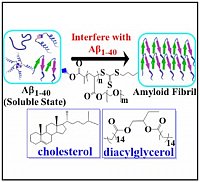
Sen MRC 2021 2100120
Membrane Anchored Polymers Modulate Amyloid Fibrillation. Sen, N., et al. Macromol. Rapid. Commun. 2021 DOI: https://doi.org/10.1002/marc.202100120
The nucleating role of cellular membrane components, such as lipid moieties on amyloid beta (Aβ1–40) fibrillation, has been reported in recent years. The influence of conjugates fabricated from lipid anchors (cholesterol, diacylglycerol) and hydrophilic polymers on Aβ1–40 fibrillation is reported here, aiming to understand the impact of polymers cloud point temperature (Tcp) and its hydrophobic tails on the amyloid fibrillation. Novel lipid-polymer conjugates, consisting of poly(oligo(ethylene glycol)macrylates) and hydrophobic groups (diacylglyceryl-, cholesteryl-, octyl-, decyl-, hexadecyl-) as anchors are synthesized using reversible addition-fragmentation chain transfer (RAFT) polymerization, allowing to tune the hydrophilic-hydrophobic profile of the conjugates by varying both, the degree of polymerization (n) and number of ethylene glycol units (m) in their side chain. The impact of these conjugates on Aβ1–40 fibrillation is investigated via in vitro kinetic studies and transmission electron microscopy (TEM). Hydrophobic lipid-anchors are significantly delaying fibrillation (both lag- and half times), observing similar fibrillar structures via TEM when compared to native Aβ1–40. Other hydrophobic end groups are also delaying fibrillation of Aβ1–40, irrespective of their “n” and “m,” whereas more hydrophilic polymers (both with longer ethylene glycol-sidechains, m = 3 for octyl, decyl and m = 5 for cholesterol) are only marginally inhibited fibrillation.
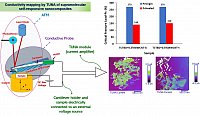
Raimondo, M. et al, Polymers, 2021, 1401
Tunneling Atomic Force Microscopy analysis of supramolecular
self-responsive nanocomposite. Raimondo, M., et al. Polymers 2021 DOI: https://www.mdpi.com/2073-4360/13/9/1401
A big step forward for composite application in the sector of structural materials is given by the use of Multi-Wall Carbon Nanotubes (MWCNTs) functionalized with hydrogen bonding moieties, such as barbiturate and thymine, to activate self-healing mechanisms and integrate additional functionalities. These materials with multiple healing properties at the same damaged site, imparted by hydrogen bonds, will also have the potential to improve material reliability, extend the service life, reduce replacement costs, and improve product safety. This revolutionary approach is obtained by integrating the non-covalent interactions coupled with the conventional covalent approach used to cross-link the polymer. The objective of this work is to characterize rubber-toughened supramolecular self-healing epoxy formulations based on unfunctionalized and functionalized MWCNTs using Tunneling Atomic Force Microscopy (TUNA). This advanced technique clearly shows the effect produced by the hydrogen bonding moieties acting as reversible healing elements by their simultaneous donor and acceptor character, and covalently linked to MWCNTs to originate self-healing nanocomposites. In particular, TUNA proved to be very effective for the morphology study of both the unfunctionalized and functionalized carbon nanotube-based conductive networks, thus providing useful insights aimed at understanding the influence of the intrinsic nature of the nanocharge on the final properties of the multifunctional composites.
Materialien für die Ewigkeit: Selbstheilende Polymere – auch rezyklierbar. Marinow, A., et al. Chemie in unserer Zeit 2021 DOI: https://doi.org/10.1002/ciuz.202100014
Während noch vor wenigen Jahren selbstheilende Materialien eher als Konzept denn als brauchbare Alternative zu bestehenden Materialien angesehen wurden, hat sich dies inzwischen geändert. Besonders wenn es um eher geringe Materialmengen in Produkten geht (Beschichtungen, Elektrolyte, elektronische Bauteile) ist der Einsatz von Selbstheilung durchaus zielführend und auch wirtschaftlich ansprechend. Auch bei Massenanwendungen wie im Automobilbereich werden solche Konzepte bereits umgesetzt. Insgesamt ist aber immer eine grundlegende technologische Anpassung von Prozessen und auch Materialien nötig, wenn man neue Wege geht. Es ist erkennbar, dass die Industrie – sicher auch im Spannungsfeld von Umweltaspekten – bereit ist, diesen Weg zu gehen und selbstheilende, neue Materialien und Polymere breitflächig einzusetzen.
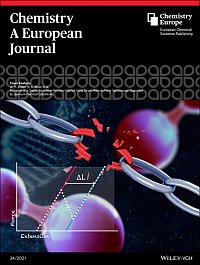
Sammon ChemEurJ 2021 Cover

Sammon ChemEurJ 2021, 8723
Activation of a Copper Biscarbene Mechano-Catalyst Using Single-Molecule Force Spectroscopy Supported by Quantum Chemical Calculations. Sammon, M. S., et al. Chem Eur. J. 2021 DOI https://doi.org/10.1002/chem.202100555 and https://doi.org/10.1002/chem.202101683
Point break: A latent copper-biscarbene mechanocatalyst becomes active when a ligand is forcefully removed. Pulling with around 2 nN breaks the copper-carbon bond, as measured by single-molecule force spectroscopy. To be able to assign the bond rupture event to the Cu−C bond, mechanophores with two different lengths of safety-line were specifically synthesized for use in this AFM experiment.
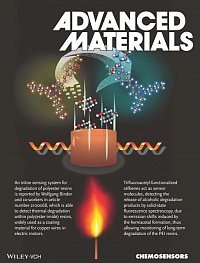
Frontispiece
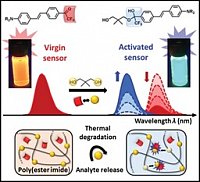
Funtan, A. AdvMater 2021 2100068
Selfdiagnostic Polymers – Inline Detection of Thermal Degradation of Unsaturated Poly(ester imide)s. Funtan, A. et al. Advanced Materials 2021 DOI: https://doi.org/10.1002/adma.202100068
Monitoring polymer degradation is an important quest, particularly relevant for industry. Although many indirect methodologies for assessing polymer degradation exist, only few are applicable for an inline-monitoring via optic detection-systems. An inline-monitoring system is introduced for the thermal degradation of crosslinked poly(ester imide)s (PEIs) by embedding trifluoroacetyl functionalized stilbene molecules, serving as chemosensors to track the release of generated alcoholic byproducts. Nucleophilic addition of an alcohol to the sensors trifluoroacetyl functionality triggers hemiacetal formation which is accompanied by significant changes in optical properties, in turn allowing monitoring of sensor activation by direct spectroscopy. Fluorescence spectroscopy offers an easy detection tool for the inline thermal monitoring of PEI-degradation.
Functional structural nanocomposites with integrated self-healing ability. Guadagno, l. et al. Materials Today: Proceedings 2021 https://www.sciencedirect.com/science/article/pii/S2214785320318253
The use of aeronautical thermosetting resins in the field of structural materials is still limited because of several drawbacks, such as the absence of electrical and thermal conductivity and the poor impact damage resistance. An important contribution for increasing the composite application in this field can be given by implementing a strategy of autonomous damage-repair and other specific functions integrated into the material structure. This work proposes a successful strategy based on the design of supramolecular self-healing systems. It is aimed at developing self-healing, load-bearing structures with all functionalities integrated into a single material able to fulfill important industrial requirements.
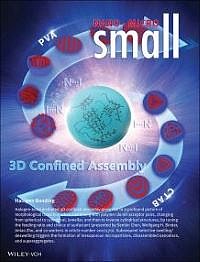
Zheng X. Small 2021 Frontispiece
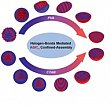
Halogen-Bond Mediated 3D Confined Assembly of AB Diblock Copolymer and C Homopolymer Blends. Zheng, X., et al. Small 2021 DOI https://doi.org/10.1002/smll.202007570
Halogen-bond driven assembly, a world parallel to hydrogen-bond, has emerged as an attractive tool for constructing (macro)molecular arrangement. However, knowledge about halogen-bond mediated confined-assembly in emulsion droplets is limited so far. An I….N bond mediated confined-assembly pathway to enable order-order phase transitions is reported here. Compared to hydrogen bonds, the distinct features of halogen bonds (e.g., higher directionality, hydrophobicity, favored in polar solvents), offers opportunities to achieve novel nanostructures and materials. Polystyrene-b-poly(4-vinyl pyridine) (PS-b-P4VP) AB diblock copolymer is chosen as halogen acceptor, while an iodotetrafluorophenoxy substituted C-type homopolymer, (poly(3-(2,3,5,6-tetrafluoro-4-iodophenoxy)propyl acrylate), PTFIPA) is designed as halogen donor, synthesized via reversible addition-fragmentation chain transfer (RAFT) polymerization. Formation of halogen bonding donor–acceptor pairs between the PTFIPA homopolymer and the P4VP segments presented in PS-b-P4VP, increase the volume of P4VP domains, in turn inducing an order-to-order morphology transition sequence: changing from spherical → cylindrical → lamellar → inverse cylindrical, by tuning the PTFIPA content and choice of surfactant. Subsequent selective swelling/deswelling of the P4VP domains give rise to further internal morphology transitions, creating tailored mesoporous microparticles, disassembled nanodiscs, and superaggregates. It is believed that these results will stimulate further examinations of halogen bonding interactions in emulsion droplets and many areas of application.
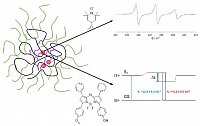
HoffmannJF AngewChemIntEd 2021 7820
Fluorescent and water dispersible single-chain nanoparticles: core-shell structured compartmentation. Hoffmann, J. F., et al. Angew. Chem. Int. Ed. 2021 DOI: https://doi.org/10.1002/anie.202015179
Single-chain nanoparticles (SCNPs) are highly versatile structures resembling proteins, able to function as catalysts or biomedical delivery systems. Based on their synthesis by single-chain collapse into nanoparticular systems, their internal structure is complex, resulting in nanosized domains preformed during the crosslinking process. In this study we present proof of such nanocompartments within SCNPs via a combination of electron paramagnetic resonance (EPR) and fluorescence spectroscopy. A novel strategy to encapsulate labels within these water dispersible SCNPs with hydrodynamic radii of ≈5 nm is presented, based on amphiphilic polymers with additional covalently bound labels, attached via the copper catalyzed azide/alkyne “click” reaction (CuAAC). A detailed profile of the interior of the SCNPs and the labels’ microenvironment was obtained via electron paramagnetic resonance (EPR) experiments, followed by an assessment of their photophysical properties.
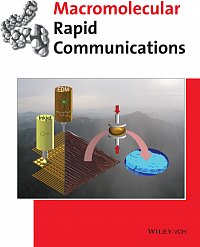
Cover MRC 2021

MacromolRapidCommun 2021 Rupp
Multicomponent stress-sensing materials fabricated by 3D-printing-methodologies. Rupp, H., Binder, W. H. Macromol. Rapid. Commun. 2021 DOI: https://doi.org/10.1002/marc.202000450
The preparation and characterization of mechanoresponsive, 3D-printed composites are reported using a dual-printing setup for both, liquid dispensing and fused-deposition-modeling. The here reported stress-sensing materials are based on high- and low molecular weight mechanophores, including poly(ε-caprolactone)-, polyurethane-, and alkyl(C11)-based latent copper(I)bis(N-heterocyclic carbenes), which can be activated by compression to trigger a fluorogenic, copper(I)-catalyzed azide/alkyne “click”-reaction of an azide-functionalized fluorescent dye inside a bulk polymeric material. Focus is placed on the printability and postprinting activity of the latent mechanophores and the fluorogenic “click”-components. The multicomponent specimen containing both, azide and alkyne, are manufactured via a 3D-printer to place the components separately inside the specimen into void spaces generated during the FDM-process, which subsequently are filled with liquids using a separate liquid dispenser, located within the same 3D-printing system. The low-molecular weight mechanophores bearing the alkyl-C11 chains display the best printability, yielding a mechanochemical response after the 3D-printing process.
Terminal flow of cluster-forming supramolecular polymer networks – single-chain relaxation or micelle reorganization? Mordvinkin, A., et al. Phys. Rev. Lett. 2020 DOI: https://journals.aps.org/prl/accepted/6907cYe2G6b10f7bf0d70da94c6a3d21a2892f6e5
We correlate the terminal relaxation of supramolecular polymer networks, based on unentangled telechelic poly(isobutylene) linear chains forming micellar end-group clusters, with the microscopic chain dynamics as probed by proton NMR. For a series of samples with increasing molecular weight, we find a quantitative agreement between the terminal relaxation times and their activation energies provided by rheology and NMR. This finding corroborates the validity of the transient-network model and the special case of the sticky Rouse model, and dismisses more dedicated approaches treating the terminal relaxation in terms of micellar rearrangements. Also, we confirm previous results showing reduction of the activation energy of supramolecular dissociation with increasing molecular weight and explain this trend with an increasing elastic penalty, as corroborated by small angle x-ray scattering data.

Döhler ACSApplPolymMater 2020
Tuning the Self-Healing Response of Poly(dimethylsiloxane)-Based Elastomers. Döhler, D. et al. ACS Appl. Polym. Mater. 2020 DOI: https://dx.doi.org/10.1021/acsapm.0c00755
We present a comprehensive investigation of mechanical properties of supramolecular polymer networks with rationally developed multistrength hydrogen-bonding interactions. Self-healing poly(dimethylsiloxane) (PDMS)-based elastomers with varying elasticity, fracture toughness, and the ability to dissipate strain energy through the reversible breakage and re-formation of the supramolecular interactions were obtained. By changing the ratio between isophorone diisocyanate (IU), 4,4′-methylenebis(cyclohexyl isocyanate) (MCU), and 4,4′-methylenebis(phenyl isocyanate) (MPU) and by varying the molecular weight of the PDMS precursor, we obtained a library of poly(urea)s to study the interplay of mechanical performance and self-healability. The Young’s moduli of the presented materials ranged between 0.4 and 13 MPa and increased with decreasing molecular weight of the PDMS precursor and increasing content of MCU or MPU units related to the formation of stronger hydrogen-bonding interactions. By exchanging MPU against MCU units, we achieved an optimum balance between mechanical properties and self-healing performance, and by the additional reduction of the molecular weight of the precursor polymer, a minimum recovery of 80% in stress within 12 h at room temperature was observed. Selected poly(urea)s could be processed via 3D printing by the conventional extrusion method, obtaining dimensionally stable and freestanding objects.
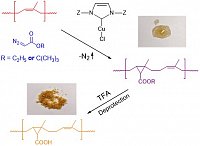
Shinde JPolymSci 2020
Cyclopropanation of Poly(isoprene) Using NHC-Cu(I) Catalysts: Introducing Carboxylates. Shinde, K., et al. J. Polym. Sci. 2020 DOI: https://doi.org/10.1002/pol.20200404
The incorporation of functional groups into unsaturated polyolefine-polymers often represent a challenging task. Based on the known cyclopropanation of double bonds with diazoesters in the presence of metal-catalysts of low molecular weight compounds, we in this article develop an approach to decorate the polymer backbone of poly(diene)s with ester as well as carboxylic groups via cyclopropanation. Therefore, predominantly cis-1,4-poly(isoprene)s are converted with ethyl or tert-butyl diazoacetate using copper(I) N-heterocyclic carbene (NHC) catalysts, while focusing on the technically relevant cyclohexane as solvent. The application of commercially available NHC-Cu(I) catalysts results in modification degrees of 4–5%, while an increased solvent polarity, like dichloromethane, results in up to 17% modification. The resulting esters were further converted to the corresponding free carboxylic groups by deprotection using trifluoroacetic acid. Thus, an introduction of functional groups along the polymer backbone with a wide variety of application, like ionic interaction or hydrogen bonding motifs, was successfully demonstrated. Its potential for upscaling makes this approach feasible for an application in large-scale production processes, such as for manufacturing of modified synthetic rubbers.
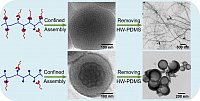
Figure I-1 Chen
Engineering the morphology of hydrogen-bonded comb-shaped supramolecular polymers: from solution self-assembly to confined assembly. Chen, S., et al. Polymer Chemistry 2020 DOI: http://dx.doi.org/10.1039/D0PY00570C .
Herein, comb-shaped hydrophobic supramolecular polymer architectures are constructed trough H-bonding interaction, subsequently challenging the formation of nanostructures under 3D confinement. Benefitting from the weak and dynamic nature of H-bonds, one building block is selectively removed while the other is maintained, affording specific nanostructures, including hollow spheres without resorting to invasive chemical degradation and cleavage. (Reproduced by permission of The Royal Society of Chemistry.)

FigureI-2 Binder
„Honig“ bis „Gummi“: Die variablen Eigenschaften des Polyisobutylen. 100 Jahre Makromolekulare Chemie. Binder, W. H. Faszination Chemie, die Informationsplattform der GDCh 2020 https://faszinationchemie.de/makromolekulare-chemie/news/honig-bis-gummi-die-variablen-eigenschaften-des-polyisobutylen-1/
Als Polyisobutylen (PIB) erstmals durch Polymerisation von Isobuten (IB) mittels Schwefelsäure hergestellt wurde, hatte der Polymerchemiker Hermann Staudinger noch acht Jahre Zeit, das Licht der Welt zu erblicken. Die uns heute vertraute (molekulare) Kettenstruktur des PIBs war damals noch unbekannt, ebenso wie sein technischer Nutzen. Seine Eigenschaften kann der Chemiker* variabel einstellen und so dient es für unterschiedliche Anwendungen: ob „kulinarisch erlebbar“ für Kaugummis, als Butylkautschuk oder in der Medizin. (Reproduced with permission. Copyright athee23/pixabay.com)
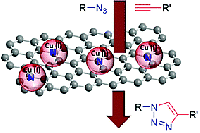
FigureI-3 Sanka
Nitrogen-doped graphene stabilized copper nanoparticles for Huisgen [3+2] cycloaddition “click” chemistry. Siva Prasanna Sanka, R. V., et al. Chemical Communications 2019, 55 (44), 6249-6252, DOI: http://dx.doi.org/10.1039/C9CC02057H .
Nitrogen-doped reduced graphene oxide (NRGO) stabilized copper nanoparticles are designed to assist Cu(i)-catalyzed Huisgen [3+2] cycloaddition “click” chemistry (CuAAC). The CuAAC at low temperature without any external additive (oxidizing/reducing agent) with high stability and recyclability is achieved. (Reproduced by permission of The Royal Society of Chemistry.)
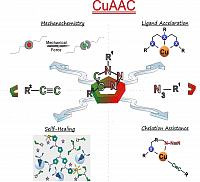
FigureI-4 Neumann
The CuAAC: Principles, Homogeneous and Heterogeneous Catalysts, and Novel Developments and Applications. Neumann, S., et al. Macromolecular Rapid Communications 2019, 1900359, DOI: https://doi.org/10.1002/marc.201900359 .
The copper-catalyzed azide/alkyne cycloaddition reaction (CuAAC) has emerged as the most useful ?click? chemistry. Polymer science has profited enormously from CuAAC by its simplicity, ease, scope, applicability and efficiency. The CuAAC with a focus on homogeneous and heterogeneous catalysts, ligands, anchimeric assistance, and basic chemical principles, ligand design and acceleration are discussed. (Reproduced by permission of WILEY-VCH Verlag GmbH & Co. KGaA, Weinheim.)
Highlights Research Focus II
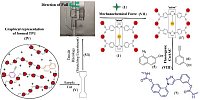
Shinde MacromolChemPhys 2023
Mechanochemical Activation of a Metal-Organic Framework (MOF) Embedded Within a TPU Matrix: Probing Fluorogenic Stress-Sensing. Shinde, K.S.; Michael, P.; Binder, W. H.*. Macromol. Chem. Phys., 2023, 2300297, https://doi.org/10.1002/macp.202300297
Here, a mechanochemically triggered Cu(I) bis(N-heterocyclic carbene [NHC))-based metal–organic framwork (MOF) embedded into a thermoplastic polyurethane (TPU)-matrix is reported. The induced fluorogenic copper-catalyzed azide–alkyne cycloaddition (CuAAC) reveals the stressed parts within the thermoplastic PU via a simple optical detection. As determined via oscillating tensile rheology on dumbbell-shaped samples of TPU, a MOF, containing 4.66% copper, catalyzes the fluorogenic CuAAC between the nonfluorescent precursor dyes, 8-azidonaphthalen-2-ol, and 3-hydroxyphenylacetylene. After mechanical activation of the MOF situated inside the TPU, the fluorescent 8-(4-(3-hydroxyphenyl)-1,2,3-triazol-1-yl)naphthalen-2-ol dye is formed. Monitoring the formation of the dye inside the TPU via fluorescence spectrometry at λex = 458 nm shows an increase of the fluorescence intensity up to 60–70%. It is demonstrated that a dumbbell-shaped TPU, subjected to higher stress, displays higher fluorescence than the surrounding other areas, thus effectively functioning as a three-in-one stress-sensor system.
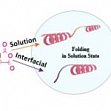
Polypeptide-PEG Conjugates via Ring Opening Polymerization of L-Alanine N-Carboxyanhydrid. Ucak, Ö.; Hause, G.; Binder, W. H.* Macromolecular Chemistry and Physics, 2022, 224 (3), 2200344, https://doi.org/10.1002/macp.202200344
The synthesis of well-defined homo- and co-polypeptides of L-alanine (L-Ala) by ring-opening polymerization (ROP) of its N-carboxyanhydride (NCAs), either via suspension/interfacial- or solution phase-polymerization using 10-undecene-1-amine and α,ω-diamino poly(ethylene glycol) (8 or 1.5 kDa) as primary amine initiators is reported. Subsequently, the folding of the homo- and triblock amphiphilic co-polypeptides under a variety of parameters such as temperature, chain length, and backbone composition and the further transitions of these secondary structures are investigated in HFIP and HFIP-H2O mixtures via circular dichroism (CD) spectroscopy. A solvent induced helical switch from a 310-helix to a α-helix when changing from HFIP to HFIP–water mixtures is observed, with water inducing helicity stronger in both, homo-polyalanine and poly(alanine)-PEG-poly(alanine) triblock copolymers.
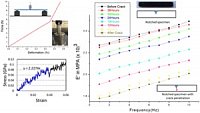
Sanka SoftMatter 2023
Self-healing nanocomposites via N-doped GO promoted “click chemistry. Siva Prasanna Sanka, R. V.; Rana, S.*; Singh P.; Mishra A. K.; Kumar, P.; Singh, M.; Sahoo, N. G.; Binder, W. H.; Yun, G. J.; Park, C., Soft Matter, 2023, 19, 98-105, https://doi.org/10.1039/D2SM01423H
N-doped graphene stabilized Cu(I)-catalyzed self-healing nanocomposites are developed, demonstrating the use of N-doped graphene as both a nanostructured material for enhancing mechanical and conductive properties to trigger self-healing via “click chemistry”. Due to an increase in electron density on nitrogen atom doping, including the coordination of N-doped rGO with Cu+ ions, nitrogen-doped graphene-supported copper particles demonstrate a higher reaction yield at room temperature without adding any external ligand/base. Tensile measurements were also performed using molecular dynamics (MD) simulations to support the findings. Given the enormous importance of autonomic repair of materials damage, this concept here reports a trustworthy and reliable chemical system with a high level of robustness.
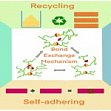
Self-healable fiber-reinforced vitrimer composites: overview and future prospect. Sharma, H.; Rana, S.*; Sigh, P.; Hayashi, M.*; Binder, W. H.*; Rosseger, E.; Kumar, A.; Schlögl S., RSC Advances, 2022, 12, 32569-32582, http://dx.doi.org/10.1039/D2RA05103F
To achieve sustainable development goals, approaches towards the preparation of recyclable and healable polymeric materials is highly attractive. Self-healing polymers and thermosets based on bond-exchangeable dynamic covalent bonds, so called “vitrimers” could be a great effort in this direction. In order to match the industrial importance, enhancement of mechanical strength without sacrificing the bond exchange capability is a challenging issue, however, such concerns can be overcome through the developments of fiber-reinforced vitrimer composites. This article covers the outstanding features of fiber-reinforced vitrimer composites, including their reprocessing, recycling and self-healing properties, together with practical applications and future perspectives of this unique class of materials.
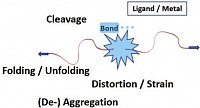
Figure II-1 Binder
The “labile” chemical bond: A perspective on mechanochemistry in polymers. Binder, W. H. Polymer 2020, 122639,
DOI: https://doi.org/10.1016/j.polymer.2020.122639 .
Currently noncovalent bonds are ranked equally important to their covalent counterparts, in particular in view of controlling macromolecules structure and assembly by pure force. With Staudinger's work expanded by mechanically driven bond-rupture in macromolecules, applications of mechanophores are highlighted in view of interfaces, stress-detection, vitrimers and self-healing. (Reproduced with permission. Copyright 2020© Elsevier B. V.)
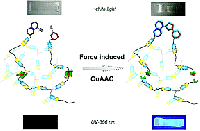
Figure II-2 Biewend
Detection of stress in polymers: mechanochemical activation of CuAAC click reactions in poly(urethane) networks. Biewend, M., et al. Soft Matter 2020, 16 (5), 1137-1141,
DOI: http://dx.doi.org/10.1039/C9SM02185J .
We report on copper(i)-bis(N-heterocyclic carbene)s (NHC) for quantitative stress-sensing, embedded within polyurethane networks, triggering a fluorogenic copper(i) azide alkyne cycloaddition (CuAAC) of 8-azido-2-naphtol and 3-hydroxy phenylacetylene. A completely transparent, force responsive poly(urethane) material is generated, allowing a quantification of the applied stress. (Reproduced with permission of The Royal Society of Chemistry.)
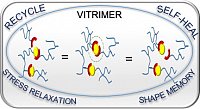
Figure II-3 Krishnakumar
Vitrimers: Associative dynamic covalent adaptive networks in thermoset polymers. Krishnakumar, B., et al. Chemical Engineering Journal 2020, 385, 123820, DOI: https://doi.org/10.1016/j.cej.2019.123820 .
The vitrimer-thermoset concept represents an important contribution to improve the durability and recyclability of thermoset-systems. The concept of Associative Dynamic Covalent Adaptive Networks (ADCAN), based on thermosetting vitrimers,demonstrates a high level of stress relaxation, self-healing and shape memory properties. This review article describes the relevant associative dynamic covalent exchange reaction mechanisms for vitrimers within thermosetting polymers and summarizes the resulting material properties with a final focus on recent applications. (Reproduced with permission. Copyright 2019© Elsevier B. V.)
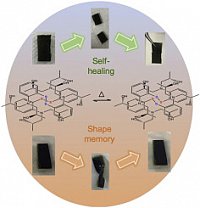
Figure II-4 Krishnakumar
Catalyst free self-healable vitrimer/graphene oxide nanocomposites. Krishnakumar, B., et al. Composites Part B: Engineering 2020, 184, 107647, DOI: https://doi.org/10.1016/j.compositesb.2019.107647 .
Catalyst free graphene oxide (GO) promoted self-healing vitrimer nanocomposites are designed, where the synthesized vitrimer nanocomposites displays self-healing properties via disulfide exchange based covalent adaptive network behavior. This study found that GO based nanofiller enhance the self-healing properties, including the shape memory and flexural strength of the materials. The GO induced lower glass transition was helpful to achieve low temperature self-healing: when compared to epoxy vitrimers (73% and 60% self-healing) the vitrimeric nanocomposites demonstrates a 88% and 80% self-healing for the first and second cycle, respectively. (Reproduced with permission. Copyright 2019© Elsevier B. V.)
Highlights Research Focus III

Rohmer ChemistryEurJ 2023
A Living Topochemical Ring-Opening Polymerization of Achiral Amino Acid N-Carboxy-Anhydrides in Single Crystal. Rohmer, M.; Ebbinghaus, S.G.; Busse, K.; Radicke, J.; Kressler, J.; Binder, W. H.*, Chemistry – A European Journal, 2023, e202302585, https://doi.org/10.1002/chem.202302585
The single-crystal ring-opening polymerization of α-aminoisobutyric acid- (Aib) and 1-aminocyclohexanecarboxylic acid- (ACHC) N-carboxyanhydrides (NCAs) is reported. Topochemical, living ring-opening polymerization (ROP) of these achiral amino-acid NCAs produces polymers of highest purity with increased chain length and high end-group fidelity as compared to conventional solution polymerization. © 2023 The Authors. Chemistry - A European Journal published by Wiley-VCH GmbH
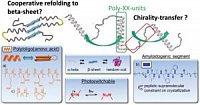
Rohmer MacromolBiosci 2023
Secondary Structures in Synthetic Poly(amino acids): Homo- and Copolymers of Poly(Aib), Poly(Glu) and Poly(Asp). Rohmer, M.; Freudenberg, J.; Binder, W. H.*, Macromolecular Biosciences, 2023, 23, 2200344, https://doi.org/10.1002/mabi.202200344
The secondary structure of poly(amino acids) is an excellent tool for controlling and understanding the functionality and properties of proteins. In this perspective article the secondary structures of the homopolymers of oligo- and poly-glutamic acid (Glu), aspartic acid (Asp), and α-aminoisobutyric acid (Aib) are discussed. Information on external and internal factors, such as the nature of side groups, interactions with solvents and interactions between chains is reviewed. As polymer- and amino acid folding is an important step for the utilization and design of future biomaterials useful for cell-adhesion and embedding, such hybrid materials open a future perspective for biomedicines.

Sen MacromolBiosci 2023
Inhibition of the fibrillation of amyloid Aβ1-40 by hybrid- lipid-polymer vesicle. Sen, N.; Haupt, C.; Hause, G.; Bacia K.; Binder, W. H.*, Macromol. Bioscience, 2023, 2200522, DOI:10.1002/mabi.202200522
The transformation of functional proteins into amyloidic plaques is responsible for the impairment of neurological functions in patients fallen victim to debilitating neurological conditions like Alzheimer's, Parkinson's, and Huntington's diseases. We investigate the influence of lipid hybrid-vesicles on alterations of the nucleation process and thus early phases of Aβ1-40 fibrillation. Hybrid-vesicles (±100 nm) are prepared by incorporating variable amounts of cholesterol-/glycerol-conjugated poly(di(ethylene glycol)macrylates)n polymers into 1,2-dioleoyl-sn-glycero-3-phosphocholine (DOPC) membranes. Such polymers, when embedded in hybrid-vesicles (up to 20%) significantly prolonged the fibrillation lag phase (tlag) compared to a small acceleration in the presence of DOPC vesicles, irrespective of the amount of polymers inside the hybrid-vesicles.
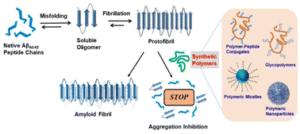
Rupali PolymerChemistry 2023
Bioinspired Synthetic Polymers-Based Inhibitors of Alzheimer’s Amyloid-β Peptide Aggregation. Rupali; Joseph, B.; Thomas, S.; Sen, N.; Paschold, A.; Binder, W. H.*; Kumar, S.* Polymer Chemistry, 2023, 14, 392-411, http://dx.doi.org/10.1039/D2PY01217K
Alzheimer's disease (AD) is a progressive neurodegenerative disease with no current cure and limited treatment solutions, wherefore discovering of novel therapies remains a global challenge in biopharmaceutical industries. This review article aims to summarize articles documenting synthetic polymer-based inhibitors of Aβ aggregations and highlight their potential as promising AD therapeutic agents.
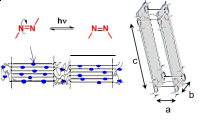
Figure III-1 Danke
Tuning layered superstructures in precision polymers. Danke, V., et al. Scientific Reports 2020, , 12119, https://doi.org/10.1038/s41598-020-68927-x
An approach to influence and control layered superstructures by varying the methylene sequence length between two consecutive functional groups in linear precision polymers containing 2,6-diaminopyridfine (DAP) group is presented. Occurrence of different layered structures depending on crystallization conditions, methylene sequence length as well as defect type is explained by a competition of H-interactions between the DAP groups and the van der Waal forces between the hydrophobic methylene groups. (Reproduced with permission. Copyright© 2020, Springer Nature.)

Figure III-2 Deike
β-Turn mimetic synthetic peptides as amyloid-β aggregation inhibitors. Deike, S., et al. Bioorganic Chemistry 2020, 104012, https://doi.org/10.1016/j.bioorg.2020.104012
Aggregation of amyloid peptides results in severe neurodegenerative diseases. We here report the preparation of beta-turn mimetic conjugates containing synthetic turn mimetic structures in the turn region of Aβ40 and Aβ16-35, replacing 2 amino acids in the turn-region G25 – K28. The structure of the turn mimic induces both, acceleration of fibrillation and the complete inhibition of fibrillation, confirming the importance of the turn region on the aggregation. (Reproduced with permission. Copyright 2020© Elsevier B. V.)
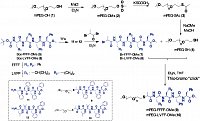
Figure III-3 Kumar
Thio-Bromo “Click” Reaction Derived Polymer–Peptide Conjugates for Their Self-Assembled Fibrillar Nanostructures. Kumar, S., et al. Macromolecular Bioscience 2020, 2000048, DOI: https://doi.org/10.1002/mabi.202000048 .
The synthesis and self-assembly of peptide-polymer conjugates into fibrillar nanostructures are reported, based on the amyloidogenic peptide KLVFF. A strategy for rational synthesis of polymer?peptide conjugates is documented via tethering of the amyloidogenic peptide segment LVFF (Aβ17-20) and its modified derivative FFFF to the hydrophilic poly(ethylene glycol) monomethyl ether (mPEG) polymer via thio-bromo based “click” chemistry. The peptide-guided self-assembling behavior of the amphiphilic supramolecular materials is investigated exhibiting fibrillar nanostructure formation in binary aqueous solution mixture. (Reproduced with permission. Copyright 2020©, WILEY-VCH Verlag GmbH & Co. KGaA, Weinheim.)
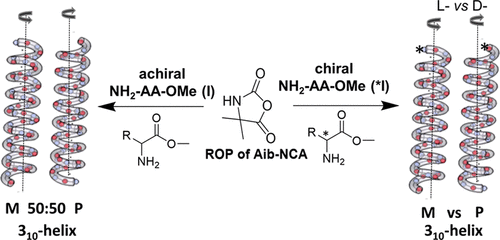
Figure III-4 Freudenberg
Chirality Control of Screw-Sense in Aib-Polymers: Synthesis and Helicity of Amino Acid Functionalized Polymers. Freudenberg, J., et al. ACS Macro Letters 2020, 686-692, DOI: https://doi.org/10.1021/acsmacrolett.0c00218 .
2-Aminoisobutyric acid (Aib) is an essential amino acid, leading to the formation of peptAibols as microbiologically active peptides and proteins. We here report on the ring-opening polymerization (ROP) of Aib-NCA (N-carboxy-anhydrides), enabling to prepare distinct Aib-polymers up to molecular weights of 1400 g/mol with precise end-group control. The attachment of chiral (D or L)-amino acids allows to systematically investigate the helical screw-sense of poly(Aib)n, resulting in chiral induction to form either left (M)- or right (P)-handed screw-senses. The approach is extended toward a switchable, chiral azo-headgroup, able to change chirality of the attached poly(Aib)n via a light-induced trigger. (Reproduced with permission. Copyright 2020©, American Chemical Society.)
Highlights Research Focus IV

Li MacromolRapidCommun 2023
Stability of Quadruple Hydrogen Bonds in an Ionic Liquid Environment. Li, C.; Bhandary, R.; Marinow,A.; Bachmann, S.; Pöppler, A.-C.; Binder, W. H.*, Macromol. Raid Commun., 2023, 2300464, https://doi.org/10.1002/marc.202300464
Hydrogen bonds (H-bonds) are highly sensitive to the surrounding environments owing to their dipolar nature, with polar solvents kown to significantly weaken H-bonds. Herein, the stability of the H-bonding motif ureidopyrimidinone (UPy) is investigated, embedded into a highly polar polymeric ionic liquid (PIL) consisting of pendant pyrrolidinium bis(trifluoromethylsulfonyl)imide (IL) moieties, to study the influence of such ionic environments on the UPy H-bonds. The content of the surrounding IL is changed by addition of an additional low molecular weight IL to further boost the IL content around the UPy moieties in molar ratios of UPy/IL ranging from 1/4 up to 1/113, thereby promoting the polar microenvironment around the UPy-H-bonds. Variable-temperature solid-state MAS NMR spectroscopy and FT-IR spectroscopy demonstrate that the UPy H-bonds are largely present as (UPy-) dimers, but sensitive to elevated temperatures (>70 °C). Subsequent rheology and DSC studies reveal that the ILs only solvate the polymeric chains but do not interfere with the UPy-dimer H-bonds, thus accounting for their high stability and applicability in many material systems. © 2023 The Authors. Macromolecular Rapid Communications published by Wiley‐VCH GmbH
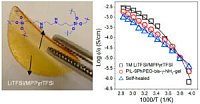
Zhou ACSApplEngMater 2023
Catalyst-Free, Mechanically Robust, and Ion-Conductive Vitrimers for Self-Healing Ionogel Electrolytes. Zhou, X.; Li, C.; Bhandary, R.; Katcharava, Z.; Du, F.; Androsch, R.; Marinow, A.; Binder, W. H.* ACS Applied Engineering Materials, 2023, 1, 8, 1997, https://doi.org/10.1021/acsaenm.3c00286
Vitrimers have been widely employed in self-healing, recyclable, and shape-shifting materials. However, the application of catalyst-free vitrimers to create self-healable and mechanically robust gel polymer electrolytes (GPEs) remains a challenge, often limiting the potential of vitrimer-based materials. Herein, we utilized a catalyst-free dynamic covalent bond (silyl ether) as a linkage to prepare self-healable and mechanically robust GPEs, which are fully reprocessable. By incorporating polymeric ionic liquids into the dynamically cross-linked networks, both ion conductivity and mechanical properties can be flexibly tuned. This dynamic feature enables self-healing and allows for reprocessing via embedding of such dynamic covalent networks into the GPEs, exhibiting good ion conductivites of 0.13 mS/cm at 20 °C and 1.88 mS/cm at 80 °C. Furthermore, the elastic modulus of the GPEs could reach a value of 0.24 MPa and was able to persist through electrode-volume expansions during charging/discharging, indicating promising applications for this type of dynamic bond in sustainable solid electrolytes.
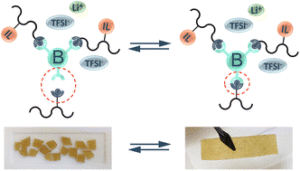
Katcharava RSCAdvances 2023
Solvent and catalyst free vitrimeric poly(ionic liquid) electrolytes for Li-ion batteries.Katcharava, Z.; Zhou, X.; Bhandary, R.; Sattler, R.; Huth, H.; Beiner, M.; Marinow, A.; Binder, W. H.*, RSC Advances, 2023, 13, 14435-14442, https://doi.org/10.1039/D3RA02396F
Polymer electrolytes (PEs) are a promising alternative to overcome shortcomings of conventional lithium ion batteries (LiBs) and make them safer for users. Introduction of self-healing features in PEs additionally leads to prolonged life-time of LIBs, thus tackling cost and environmental issues. We here present solvent free, self-healable, reprocessable, thermally stable, conductive poly(ionic liquid) (PIL) consisting of pyrrolidinium-based repeating units. The dynamic boronic ester linkages allow reprocessing (at 40 °C), reshaping and self-healing ability of PEs. Such vitrimeric PILs rcan be subjected to 3D printing via FDM, offering the possibility to design batteries with more complex and diverse architectures.
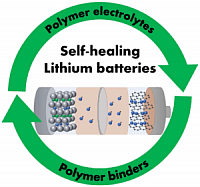
Marinow Polymers 2023
Self‐Healing Polymer Electrolytes for Next‐Generation Lithium Batteries. Marinow*, A.; Katcharava, Z.; Binder, W. H.*, Polymers, 2023, 15, 1145, https://doi.org/10.3390/polym15051145
The integration of polymer materials with self-healing features into advanced lithium batteries is a promising and attractive approach to mitigate degradation and, thus, improve the performance and reliability of batteries. This paper comprehensively reviews various categories of self-healing polymer materials for application as electrolytes and adaptive coatings for electrodes in lithium-ion (LIBs) and lithium metal batteries (LMBs). We discuss the opportunities and current challenges in the development of self-healable polymeric materials for lithium batteries in terms of their synthesis, characterization and underlying self-healing mechanism, as well as performance, validation and optimization.

Li Polymers 2023
Synthesis and Characterization of Quadrupolar-Hydrogen-Bonded Polymeric Ionic liquids for Potential Self-Healing Electrolytes. Li, C.; Bhandary, R.; Marinow, A.; Ivanov, D.; Du, M.; Androsch, R.; Binder *, W.H. Polymers, 2022, 14 (19), 4090, https://doi.org/10.3390/polym14194090
Within the era of battery technology, the urgent demand for improved and safer electrolytes is immanent. In this work, novel electrolytes, based on pyrrolidinium-bistrifluoromethanesulfonyl-imide polymeric ionic liquids (POILs), equipped with quadrupolar hydrogen-bonding moieties of ureido-pyrimidinone (UPy) to mediate self-healing properties were generated. By combining the results from differential scanning calorimetry (DSC), broadband dielectric spectroscopy (BDS), and rheology, a decoupled conductivity of the POILs from the glass transition was revealed. Tensile tests for both pristine and self-healed samples, evidenced a rational design of self-healing electrolytes bearing both hydrogen bonding moieties and low-molecular-weight polymeric ionic liquids.
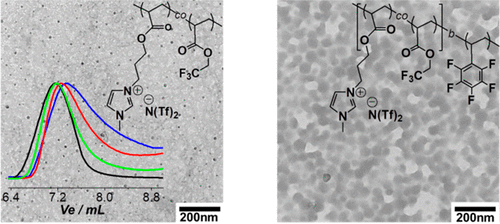
Figure IV-1 Chen
Synthesis and Morphology of Semifluorinated Polymeric Ionic Liquids. Chen, S., et al. Macromolecules 2018, 51 (21), 8620-8628, DOI: https://doi.org/10.1021/acs.macromol.8b01624 .
Polymeric ionic liquids (POILs) are important materials in the field of ionic liquid gating. Reversible addition–fragmentation chain-transfer polymerization (RAFT) technique is applied to prepare three imidazolium-based acrylates with different counterions. Polymerization rate increase in the order of BF4Θ < PF6Θ < N(Tf)2Θ. Copolymerization with a semifluorinated monomer 2,2,2-trifluoroethyl acrylate (TFEA) was successful. The morphology and size of such semifluorinated POILs reveals the aggregated nanoparticles from P(APMIN(Tf)2-co-TFEA) due to the mesoscale organization of the ionic “multiplets”. (Reproduced with permission. Copyright 2018©, American Chemical Society.)

Figure IV-2 Chen
Gating effects of conductive polymeric ionic liquids. Chen, S., et al. Journal of Materials Chemistry C 2018, 6 (30), 8242-8250, DOI: http://dx.doi.org/10.1039/C8TC01936C .
In this study, we investigate POILs as a gating material within a field-effect transistor, additionally describing their glassy dynamics and charge transport properties. The gating effects of these POILs are studied in detail, showing for the first time a reversible phase transition between thin films formed from the brownmillertite phase SrCoO2.5 and the perovskite phase SrCoO3 by use of such POILs. This is especially pronounced for POIL 1: P(APMIN(Tf)2) homopolymer displaying gate voltages (VG) of 3–4 V and a gating time of ∼4 h. (Reproduced by permission of The Royal Society of Chemistry.)

Figure IV-3 Osim
Surface modification of MoS2 nanoparticles with ionic liquid-ligands: towards highly dispersed nanoparticles. Osim, W., et al. Chemical Communications 2013, 49 (81), 9311-9313, DOI: http://dx.doi.org/10.1039/C3CC45305G .
Highly dispersible MoS2 nanoparticles have been prepared via surface-modification using a novel tetraethylene glycol-based ionic liquid containing a chelating moiety attached to the cation. The choice of the respective ligand enables the generation of highly dispersible MoS2 nanoparticles with either polar, hydrophobic or "amphiphilic" surfaces, forming highly stable dispersions or microemulsions. (Reproduced by permission of The Royal Society of Chemistry.)
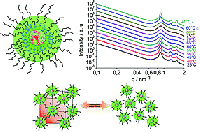
Figure IV-4 Stojanovic
Designing melt flow of poly(isobutylene)-based ionic liquids. Stojanovic, A., et al. Journal of Materials Chemistry A 2013, 1 (39), 12159-12169, DOI: http://dx.doi.org/10.1039/C3TA12646C .
A series of novel poly(isobutylene)-based stable ionic liquids (PIB-ILs) with strongly temperature dependent nano- and mesostructures is reported. Modifying both the anchored cation and anion as well as the molecular weight of the attached polymer chain, the nanostructure and the viscoelastic behavior of PIB-ILs can be engineered. All investigated PIB-ILs exhibited a defined nano- and mesoscale ordering at room temperature, whereas the nature of the anchored cation showed a strong impact on the temperature-dependence of the mesoscale-structure as well as on the flow behavior of PIB-ILs. (Reproduced by permission of The Royal Society of Chemistry.)
Highlights Research Focus V
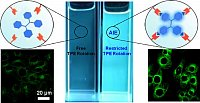
Li ACSMacroLetters 2023
Hydrogen-Bonded Polymer Nanomedicine with AIE Characteristic for Intelligent Cancer Therapy. Li, Z.; Chen*, S.; Binder, W. H; Zhu*, J., ACS Macro Lett., 2023, 12, 10, 1384–1388, https://doi.org/10.1021/acsmacrolett.3c00493
Hydrogen-bonding (H-bonding) assembly incorporated with an aggregation-induced emission (AIE) capability can serve as a powerful tool for developing supramolecular nanomedicine with clear tumor imaging and smart therapeutic performance. We here report a H-bonded polymeric nanoformulation with an AIE characteristic toward smart antitumor therapy. To do so, we first design a structurally novel tetraphenylethylene (TPE)-based H-bonding theranostic prodrug, TPE-(FUA)4, characterized by four chemotherapeutic fluorouracil-1-acetic acid (FUA) moieties arched to the TPE core. A six-arm star-shaped amphiphilic polymer vehicle, P(DAP-co-OEGEA)6, is prepared, bearing hydrophilic and biocompatible POEGEA (poly(oligo (ethylene glycol) ethyl acrylate) segments, along with a hydrophobic and H-bonding PDAP (poly(diaminopyridine acrylamide)) segment. Thanks to the establishment of the DAP/FUA H-bonding association, incorporating the TPE-(FUA)4 prodrug to the P(DAP-co-OEGEA)6 vehicle can yield H-bond cross-linked nanoparticles with interpenetrating networks. For the first time, AIE luminogens are interwoven into a six-arm star-shaped polymer via an intrinsic H-bonding array of the chemotherapeutic agent FUA, thus imposing an effective restriction of TPE molecular rotations. Concomitantly, encapsulated photothermal agent (IR780) via a hydrophobic interaction facilitates the formation of nanoassemblies, TPE-(FUA)4/IR780@P(DAP-co-OEGEA)6, featuring synergistic cancer chemo/photothermal therapy (CT/PTT). Copyright © 2023, American Chemical Society
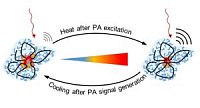
Thümmler ChemCommun 2023
Thermoresponsive Swelling of Photoacoustic Single-Chain Nanoparticles. Thümmler, J.F.; Maragani, R.; Schmitt, F.-J.; Tang, G.; Mahmoudi Rahmanlou, S.; Laufer, J.; Lucas, H.; Mäder, K.; Binder, W. H.*, Chemical Communications, 2023, 59, 11373 - 11376, https://doi.org/10.1039/D3CC03851C
NIR-fluorescent LCST-type single-chain nanoparticles (SCNPs) change their photophysical behaviour upon heating, caused by depletion of water from the swollen SCNP interiors. This thermoresponsive effect leads to a fluctuating photoacoustic (PA) signal which can be used as a contrast mechanism for PA imaging.

Lehner IntJPharmaceutics 2023
Towards the optimization of drug delivery to the cochlear apex: Influence of polymer and drug selection in biodegradable intracochlear implants. Lehner, E.; Honeder, C.; Knolle, W.; Binder, W.H.; Scheffler, J.; Plontke, S.K.; Liebau, A.; Mäder, K., International Journal of Pharmaceutics, 2023, 643, 123268, https://doi.org/10.1016/j.ijpharm.2023.123268
There is growing need for new drug delivery systems for intracochlear application of drugs to effectively treat inner ear disorders. In this study, we describe the development and characterization of biodegradable, triamcinolone-loaded implants based on poly(lactic-co-glycolic acid) (PLGA) and polyethylene glycol–poly(lactic-co-glycolic acid) (PEG-PLGA) respectively, prepared by hot-melt extrusion. PEG 1500 was used as a plasticizer to improve flexibility and accelerate drug release. PEG-PLGA implants showed an initial slow release rate over several days regardless of the amount of PEG added. Mathematical simulations of the pharmacokinetics of the inner ear based on the in vitro release kinetics indicate a complete distribution of triamcinolone in the whole human scala tympani, which underlines the high potential of the developed formulation.

Zhou Biomacromolecules 2022
Core-Coordinated Elliptic Polymer Nanoparticles Loading Copper(II) and Chlorambucil for Cooperative Chemodynamic/Chemotherapy. Qiu, X.; Li, Z.; Wu, Y.; Binder, W. H.; Chen*, S.; Zhou*, J., Biomacromolecules, 2022, 23, 11, 4519, https://pubs.acs.org/doi/10.1021/acs.biomac.2c00656
Chemodynamic therapy (CDT) reflects an innovative cancer treatment modality. To enhance its relatively low therapeutic efficiency, rational combination with extra therapeutic modes is highly appreciated. Here, core-coordinated amphiphilic, elliptic polymer nanoparticles (Cu/CBL–POEGEA NPs) are constructed via the self-assembly of a glutathione (GSH)-responsive polymer–drug conjugate. Side-chain acylthiourea (ATU) motifs are affixed, which behave as ligands capable of coordinating Cu(II). Benefitting from the GSH-induced reduction reaction, Cu(II) is converted into Cu(I) and subsequently react with endogenous H2O2 to create •OH, realizing GSH-depletion-promoted CDT. Additionally, the disulfide bond endows GSH-responsive CBL release and provokes further GSH decline, finally realizing combined CDT/CT toward enhancing antitumor outcomes, and in vitro as well as in vivo studies indeed reveal remarkable efficacy.
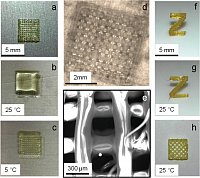
Figure V-1 Rupp
3D Printing of Supramolecular Polymers: Impact of Nanoparticles and Phase Separation on Printability. Rupp, H., et al. Macromolecular Rapid Communications 2019, 1900467, DOI: https://doi.org/10.1002/marc.201900467 .
3D printing of linear and three-arm star supramolecular polymers with attached hydrogen bonds and their nanocomposites is reported. The linear and three-arm star poly(isobutylene)s PIB-B2 (Mn = 8500 g mol -1), PIB-B3 (Mn = 16 000 g mol -1), and linear poly(ethylene glycol)s PEG-B2 (Mn = 900 g mol-1, 8500 g mol -1) are prepared and then probed by melt-rheology to adjust the viscosity to address the proper printing window. A blend of the linear polymer PIB-B2 and the three-arm star polymer PIB-B3 (ratio ≈ 3/1 mol) reaches an even higher structural stability, able to build free-standing structures. (Reproduced by permission. Copyright © 2019 WILEY-VCH Verlag GmbH & Co. KGaA, Weinheim.)
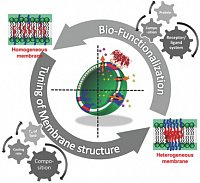
Figure V-2 Schulz
Mixed Hybrid Lipid/Polymer Vesicles as a Novel Membrane Platform. Schulz, M., et al. Macromolecular Rapid Communications 2015, 36 (23), 2031-2041, DOI: http://dx.doi.org/10.1002/marc.201500344 .
Vesicles can be individually fabricated from naturally occurring lipid or synthetic block copolymer molecules via self-assembly in aqueous solutions. Upon merging the best properties of lipo- and polymersomal membranes, hybrid lipid/polymer vesicles represent a new scaffold for medical applications combining, e.g., combining the biocompatibility of liposomes with the high thermal and mechanical stability and functional variability of polymersomes within a single vesicle type. (Reproduced by permission. Copyright © 2015 WILEY-VCH Verlag GmbH & Co. KGaA, Weinheim.)

Figure V-3 Olubummo
Controlling the Localization of Polymer-Functionalized Nanoparticles in Mixed Lipid/Polymer Membranes. Olubummo, A., et al. ACS Nano 2012, 6 (10), 8713–8727, DOI: http://dx.doi.org/10.1021/nn3023602 .
In this paper, we demonstrate the preparation and characterization of polymer-functionalized CdSe NPs, tuning their interaction with mixed lipid/polymer membranes from 1, 2-dipalmitoyl-sn-glycero-3-phophocholine (DPPC) and PIB87-b-PEO17 block copolymer by varying their surface-hydrophobicity. Reproduced with permission. (Copyright 2012©, American Chemical Society.)
